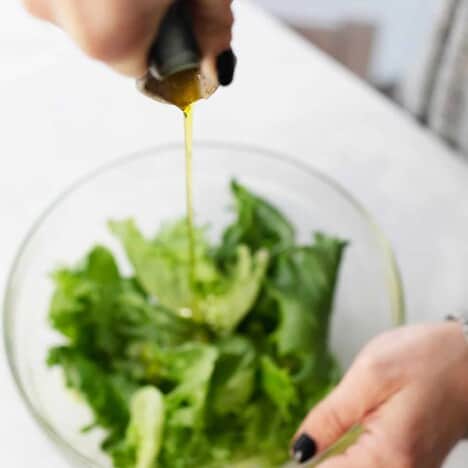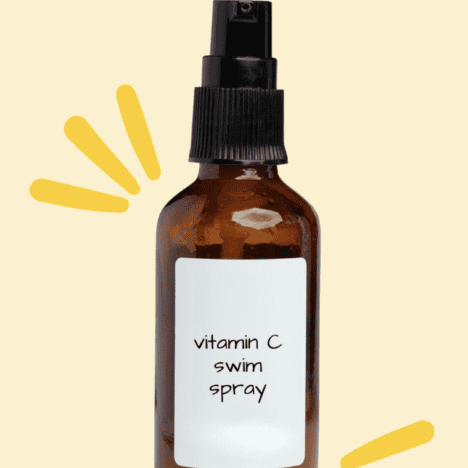This post may contain affiliate links. Please read my disclosure policy.
If you are like me, and you use olive oil near daily, it’s important to know a little about how the quality of it matters! I’m deep diving into Everything You Need the Know About Olive Oil today!
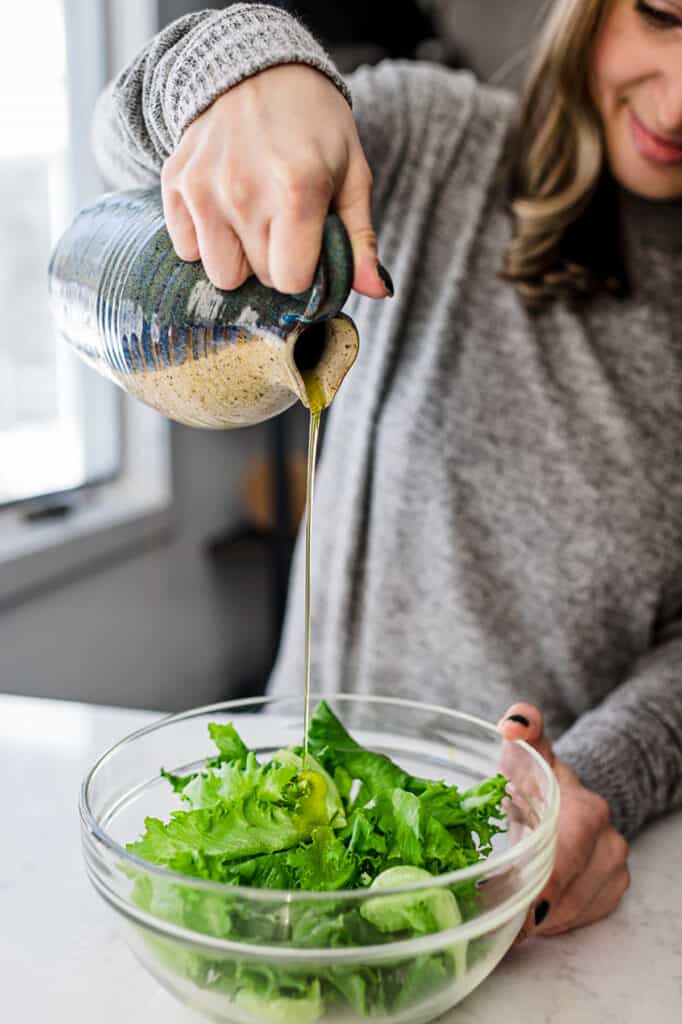
If you spend a lot of time cooking, you probably use quite a bit of olive oil.
Olive oil is a staple in so many savory recipes… and even some sweet ones! But many of us — myself included — don’t actually know that much about it. And if you know me, you know that any time there’s something that I’m putting in my body (not to mention giving it to my loved ones) frequently, I want to learn as much as I can about it. I think it’s about time for an olive oil deep dive!
Let’s start with the basics.
How is olive oil made?
This is very obvious, but we’re deep diving here, so bear with me: olive oil comes from olives.
Olive oil production has a deep history in the Mediterranean region, where many generations of olive growers have passed their secrets down for many decades. Before they can be turned into olive oil, olives must be cared for so they can mature for several years. Tending to olives is a meticulous process that requires lots of pruning. Producing olive oil is a matter of both quality and quantity — at least ten pounds of olives are required to make just one liter of olive oil.
Olives are picked — sometimes by hand — and transported to a processing plant. Typically, processing happens quickly after harvest to avoid any damage to the olives and to maintain their quality. Leaves, twigs, and stems are removed and the olives are washed before they are crushed by stainless steel rollers and ground into a paste.
Next up is malaxation, a process in which water is slowly stirred into the olive paste. The mixture is then stirred for an additional 20 to 40 minutes — long enough to give the oil more flavor, but not long enough to expose it to quality-compromising free radicals in the air. Some plants use closed mixing chambers to prevent this oxidation during mixing.
The olive paste is put on mats, further pressed, and then sent through a centrifuge to filter out any solid remnants from the paste. Water and oil are extracted from the centrifuge to be separated later on. The oil is then refined, bleached, and/or deodorized based on the manufacturer’s traditions, preferences, and recipes. It’s then stored in stainless steel containers at 65* F until it’s bottled and shipped.
From there, it finds its way to a store near you and then to your kitchen!
As you may already know, there’s more than one type of olive oil. We’ll get into that next.
Types of Olive Oil
Now that we understand the basics of olive oil production, let’s consider the varieties of olive oil that are available. The production process is different for each one.
- Extra Virgin Olive Oil. When it comes to olive oil, this is the best of the best! If you’re going to keep one bottle of olive oil in your kitchen, EVOO is probably the way to go. Extra virgin olive oil is made from olives that have the least amount of rotting because they’ve been crushed shortly after harvest. It’s hard to argue with that! EVOO also must pass a taste test with a panel of judges before it’s sold so it has the best flavor.
- Virgin Olive Oil. One step down from EVOO, you’ve got virgin olive oil. The olives in virgin olive oil typically sit longer between harvesting and crushing, so they have a higher acidity content. It works for sauteing, roasting, baking, frying, and sauces, but isn’t recommended for dressing or finishing dishes, since it doesn’t taste nearly as good as EVOO.
- Olive Oil. You’re probably picking up on a pattern here, right? If you’re guessing that standard-issue olive oil is yet another step down from virgin olive oil in terms of quality, you’re right. It’s bleached, neutralized, and deodorized during refining and should really only be used when you’re sauteing, roasting, and mid-temperature frying, when the flavor won’t make a difference.
- Light Olive Oil. This is a lower-quality olive oil that’s blended with other highly refined oils. It doesn’t share the health benefits of other EVOO or virgin olive oil, but, like plain olive oil (above!), you can use it for basic kitchen tasks if you need to.
- Olive Pomace Oil. After olives are pressed, the solid pulp that’s left over is known as pomace, which can then be turned into an oil. Chemical solvents are used to produce it, so if you see “olive pomace oil” on a label, you should probably stay away from it.
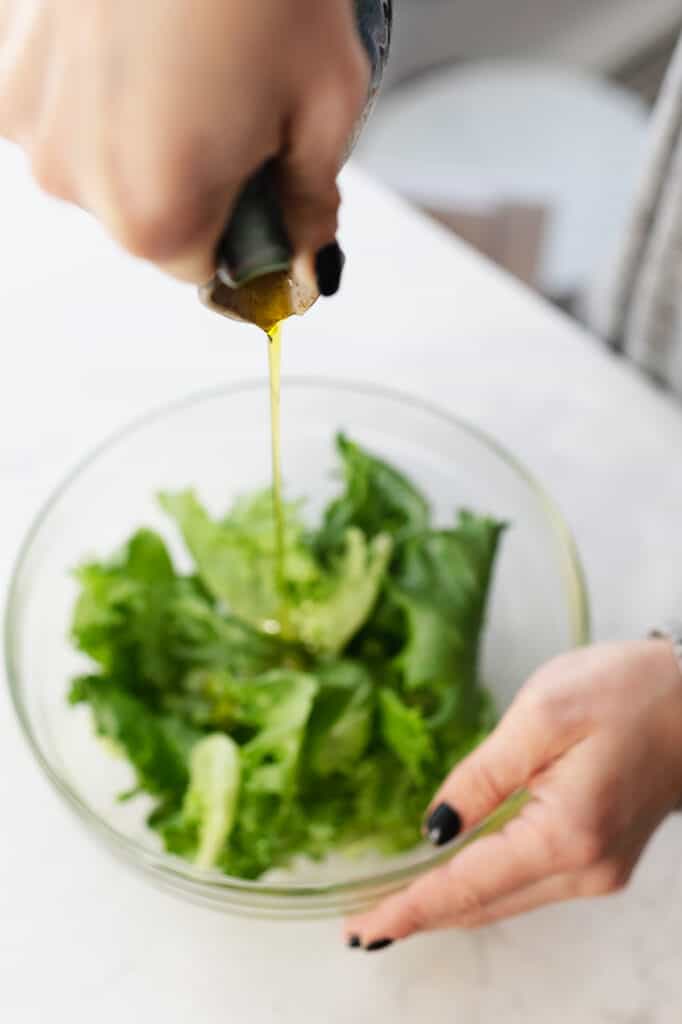
Health Benefits of Olive Oil
I mentioned above that EVOO and virgin olive oil have health benefits. You’ve probably heard about those benefits, especially relative to other oils and butter.
Here are a few of the benefits of olive oil, according to Healthline:
- It’s rich in healthy monosaturated fats like omega-3 and omega-6 fatty acids.
- Olive oil is rich with antioxidants, which can reduce the risk of chronic disease.
- It reduces inflammation throughout the body. Experts believe chronic inflammation contributes to conditions ranging from cancer and heart disease to type 2 diabetes and Alzheimer’s disease.
- It’s been proven to help prevent strokes and to protect against heart disease.
- Even though it’s a fat, olive oil is not associated with weight gain or obesity, which makes it a great alternative to butter and other oils.
- It has antibacterial properties that might help fight bacteria in the stomach.
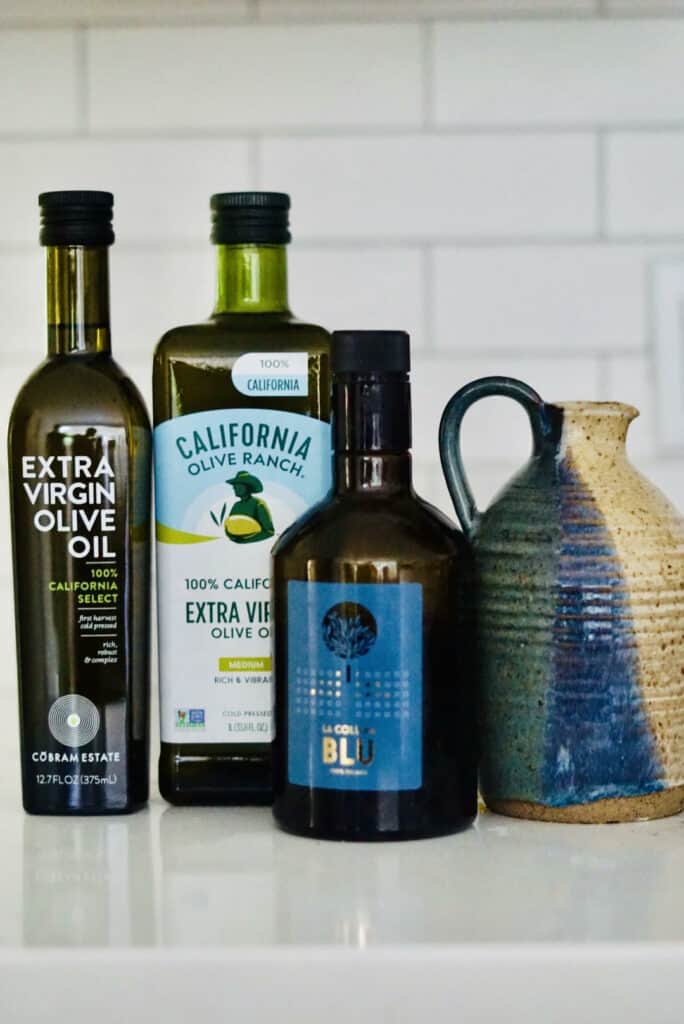
Shopping for Olive Oil
But how do you pick the right olive oil to use in dishes for you and your family? If you’re incorporating olive oil into your regimen for its health properties (and delicious flavor, of course), I’m sure you want to make sure you’re choosing a high-quality product.
Here are a few things to look for and to avoid…
Pay attention to these markers of quality olive oil next time you’re shopping for it…
- As you read above, extra virgin olive oil is generally the best you can get in the olive oil aisle. If it’s labeled EVOO, there’s a good chance it’s a quality product.
- The best olive oil producers in the game usually label their oil with a harvest date. Keep your eyes open for dates before you buy.
And here are a few things to be cautious of…
- Clear glass bottles are bad news, even if they have a pretty label. Light can be very damaging to olive oil, so if it comes in a clear bottle, it’s likely already been compromised.
- Don’t be deceived by the phrase “first cold pressing!” This isn’t necessarily a bad thing, but it’s also technically redundant, so be mindful of the fact that manufacturers might be using it to oversell their product.
How to Properly Store Olive Oil
Once you’ve picked out your ideal bottle of olive oil, you’ll want to be sure to store it properly so that it stays fresh. Unlike wine and cheese, olive oil doesn not always get better with time and will diminish in quality if it’s not taken care of.
Keep your olive oil in a cool, dark environment to protect it from light and heat, both of which are its enemies. Then, use it! Don’t let it sit around for too long, because the sooner you incorporate it into recipes, the fresher it will be. And since it has all of those health benefits, you don’t need to stress about incorporating it liberally.
A note about cooking with olive oil…
Olive oil’s smoke point — which is just a fancy term for the temperature at which any cooking fat stops shimmering and starts smoking — has been a little controversial among foodies and other experts. It’s worth noting that fats and oils with higher smoke points have generally been subjected to industrial-level refinement processes like bleaching, filtering, and high-temperature heating. Fats and oils with lower smoke points have had lower interventions.
In recent years, there has been some concern that heating olive oil to its smoke point — somewhere between 325 and 375* F — might release harmful compounds into the food being prepared. This, of course, sounds dangerous!
According to U.S. News Health, it’s actually very rare that you fully hit olive oil’s smoke point when working with it. They reassure consumers that there’s little reason to worry about this issue — but it’s still something to be aware of.
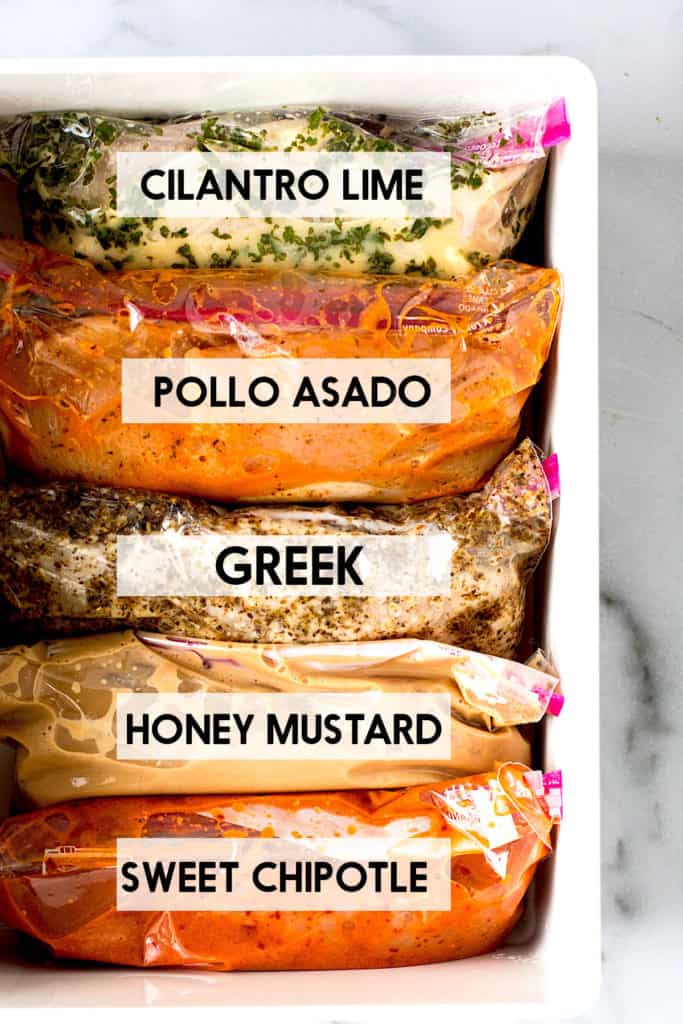
Check out a few of my favorite recipes featuring olive oil…
- How to Make a Nut Free Basil Pesto
- Healthy Green Goddess Dressing
- Sausage and Vegetable Pasta
- The Best Gluten Free Pizza Crust
- 5 Chicken Marinades (Freezer-Friendly)
Bon appetit!
